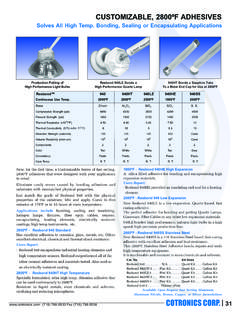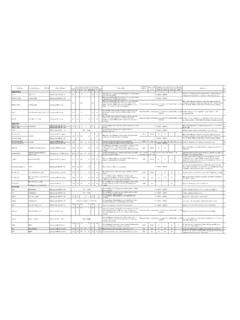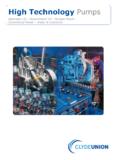Transcription of Technical Note: Using Guided Wave Radar for Level in High ...
1 Technical Note Using GWR for Level in high pressure steam applications 00840-0100-4530, Rev DB October 2016. Using Guided Wave Radar for Level in high pressure steam applications Key points Accurate and reliable Level measurement under changing process conditions with Dynamic Vapor Compensation Meeting the extreme temperature and pressure challenges with robust probe design and multiple layers of protection Low maintenance with no moving parts to freeze or stick Introduction This document describes the advantages of Using a Rosemount 5300.
2 Series Guided Wave Radar (GWR) with Dynamic Vapor Compensation in high pressure saturated steam applications , such as boiler drums, high pressure feedwater heaters and steam separators. GWR is used for direct Level measurement and is completely independent of density. With no moving parts, it offers the advantages of lower maintenance and greater reliability. Challenges It is a challenge to measure Level accurately and reliably in high pressure saturated steam applications . Level is critical for safe operation and good measurement helps to optimize plant performance.
3 Application challenges for good Level measurement include: Phase changes Extreme high pressures and temperatures Magnetite coating Vibrations Phase changes It is especially common during startup to experience varying temperature and pressure . Both the liquid and steam phases of the system will have density changes as the system reaches the operating temperature and pressure . That can cause up to 30 percent error for temperatures up to 600 F (315 C). Using GWR for Level in high pressure steam applications Technical Note October 2016 00840-0100-4530, Rev DB.
4 Any density-based Level measurement device will need compensation to discern the actual Level from the density-associated errors. Algorithms have been developed to make this compensation as seamless as possible in the control systems, but require input of operating pressure as well as Level . Compensation can be slow which results in erroneous reading. There will also be dielectric property changes both in the liquid and steam phases. steam under high pressure and temperature will slow down the propagation speed of a Radar signal which can cause up to a 20% error, if not compensated.
5 Specific gravity and dielectric constant - Uncompensated error 1985 (137) 50. 1735 (120). pressure psig (bar). 40. 1485 (102). % Error 1235 (85) 30. 985 (68). 735 (51) 20. 485 (33). 10. 235 (16). -15 (-1) 0. 0 100 200 300 400 500 600. (-18) (38) (93) (149) (204) (260) (316). Temp F ( C). Saturated steam curve SG % error over temperature DK % error over temperature Both the density (SG) and dielectric (DK) properties of water and steam change with pressure and temperature. If not compensated, significant errors may occur.
6 Even though the dielectric of water decreases with temperature increase, the Level can be measured as long as the water dielectric remains sufficiently high , which results in a reflection back from the surface. Reliable measurements within the specified accuracy can even be maintained up to pressures and temperatures of 2610psi (180 bar) and 676 F (358 C). Extreme high pressures and temperatures In these applications temperatures above 300 F (150 C) and pressures above 580 psi (40 bar). are common. Therefore, having robustly designed equipment which prevents leakage and performs reliably is vital for safety.
7 Magnetite coating While these applications are generally considered to be composed of clean water and steam , it is normal to have a layer of magnetite on metallic surfaces. In some cases, the deposits can be heavy enough to cause some mechanical linkages to freeze and stick resulting in a need for maintenance. With no moving parts in the GWR probe assembly, magnetite poses no issues for sticking. 2 Using GWR for Level in high pressure steam applications Technical Note Using GWR for Level in high pressure steam applications 00840-0100-4530, Rev DB October 2016.
8 Vibrations Vibrations from pumps can cause a noisy signal from mechanical-based techniques. Solution Advantages of GWR over other techniques Since GWR measurement devices are completely independent of density, these associated errors are not present, thus eliminating the need for this compensation. GWR has no moving parts that can freeze or stick from magnetite coating or cause noisy signals due to vibration. Therefore, GWR offers additional advantages of lower maintenance and greater stability. Dynamic Vapor Compensation functionality In the Rosemount 5300 Series GWR, Dynamic Vapor Compensation is used to compensate vapor space dielectric in steamy applications .
9 This becomes more important for high pressure applications which may have more variations in the operating conditions or where the users want to be able to verify the unit under near ambient conditions, such as during start-up and shut down, without having to modify the vapor dielectric settings. The compensation occurs in the transmitter electronics and a corrected Level measurement is provided to the control system. No additional compensation is required. Table 1. Error Distance with Changing Temperature and pressure without Vapor Compensation Temp.
10 ( F/ C) pressure (psia/bar) DK of liquid DK of vapor Error in distance %. 100/38 1 200/93 14/1 300/149 72/5 400/204 247/17 500/260 681/47 600/316 1543/106 618/325 1740/120 649/343 2176/150 676/358 2611/180 48. 691/366 2900/200 699/370 3046/210 702/372 3120/215 Above critical point, distinct liquid and gas phases do not exist. As seen in Table 1, at 247 psia (17 bar), there is an error in distance of At 1543 psia (106. bar), there is an error of when there is no compensation for the vapor dielectric. Using GWR for Level in high pressure steam applications 3.

















